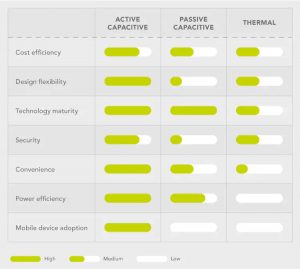Since fingerprint touch sensors were first integrated into smartphones more than five years ago, fingerprint authentication has rapidly replaced PIN codes as consumers’ preferred method for unlocking phones. By delivering an added layer of security while enhancing the user experience, fingerprint sensors in the mobile space have paved the way for biometric adoption across a wide range of devices.
From payment cards to wearables and USB dongles to IoT devices, new biometric form factors are growing explosively and are now available in a wide range of form factors (fingerprint, iris, face, etc.), each one optimized for a specific application. For smartcards, though, fingerprint sensors are really the only viable option, given the way they are used.
A Tall Order
The fingerprint sensor, which is used to “read” your fingerprint during the payment transaction, presents a number of design challenges. In general, it needs to be very small, so it’s cost-effective and easy to place on the card, but it also needs to perform very well, with a high level of image quality, to ensure reliable authentication and a positive user experience.
When it came time to select a sensor for our fingerprint on card solution, NXP’s development team added a few more requirements to the list. We wanted to keep the overall design of our fingerprint on card solution as streamlined as possible, without extra components for a power supply, so the sensor had to be power efficient and capable of operating using only the 1.5A/m supplied by the payment terminal.
At the same time, we wanted a sensor that worked quickly enough to meet our operating budget of one second for all three steps in fingerprint verification: sensing and image transfer, extraction, and matching. The less time we used for sensing and image transfer, the more time we had available for the compute-intensive steps of extraction and matching, especially since we use the secure element to do the processing.
Our search for the right sensor led us to the Swedish company Fingerprints, a recognized expert in sensor technology for biometric authentication. Not only has Fingerprints played a major role in the development of fingerprint sensors for smartphones, they’ve shipped more than a billion sensors for biometric authentication in general.
The Fingerprints approach to Fingerprint on Card Technology
The technology experts at Fingerprints gave us a quick tutorial on the types of sensors available for use with fingerprint on card technology and the features that would deliver the speed and efficiency we wanted. Here’s a summary of what they had to say:
Sizing up the Options
While there are many different types of biometric technologies, and fingerprints are the obvious choice for smartcard biometrics, the selection process for a sensor to be used with fingerprint on card technology doesn’t end there.
Having analyzed the pros and cons of different sensors, the active capacitive technology is the best option for integration onto a smartcard. Active capacitive sensors generate an image by measuring the variations in electrical capacitance created by the ridges and valleys in the fingerprint and are, unlike passive capacitive, robust and works for different skin types and conditions, while thermal sensors generate an image by measuring the variations in temperature that ridges and valleys create and are more power hungry.
Bigger DOESN’T mean better
Active capacitive sensors are the number-one choice for smartphones, in part because they deliver the necessary image quality and also because they enable a positive user experience. The goal was to optimize an active capacitive sensor so they could migrate that combination of quality and convenience from a phone to a smartcard.
Advances, made possible by extensive R&D, are making fingerprint sensors thinner, more flexible, and power-efficient enough to make integration into a payment card possible.
Software makes the Difference
The hardware used to create the sensor provides the right foundation for fingerprint authentication but, the software behind the sensor is where the “magic” really happens. Better quality software can reduce the processing power and memory that is needed on the device, reducing touch times dramatically. The best software, right now, is even allowing smaller sensors to be made, cutting the cost of solutions and giving device makers even more flexibility for design and integration.
Further advantages of a sensor software is to keep the sensor in standby mode, so it is ready to go whenever it’s needed. The software should also take into account the fact that people don’t always touch the sensor in exactly the same way, so a high-quality image can be generated from a variety of touch angles.
Speed is essential
Operational speed is fundamental to the convenience of fingerprint biometrics. The verification process, which includes image capture, image transfer, feature extraction, and template matching – has to happen so quickly that it’s almost imperceptible. If the sensor’s work, as part of image capture and transfer, takes too long, then there may not be enough time left for the rest of the process to finish in time. It makes the difference between what Fingerprints calls “tap and go” and “tap and slow.”
To compensate for a slow sensor, designers may try to save time by using a low-cost microcontroller, instead of the onboard secure element, for the matching step. This is a risky approach, though, since it means performing calculations outside the protected environment of the secure element. As discussed in an earlier blog, using the secure element for matching keeps data in a safe environment. Moving these steps outside of the secure element, to save on processing time, significantly weakens security.
Using software optimization, Fingerprint tailored their sensor to optimize image quality while reducing touch times, with the result that capturing and transferring an image requires less than 0.1 seconds to complete. This leaves enough time to do all the necessary processing within the secure element while still meeting NXP’s goal of completing fingerprint authentication within one second.
Power Efficiency Yields Processing Efficiency
Power efficiency is another factor in sensor performance. As already said, a fingerprint sensor must be optimized to work, without assistance of a battery or super capacitor, off the power provided by the payment terminal, which is a minimum of 1.5A/m. Otherwise, verification would likely take longer than one second.
Putting the Pieces Together
Based on Fingerprints’ recommendations, NXP chose the FPC T-Shape sensor FPC1321 for our Fingerprint on Card solution which is a modified version of their successful mobile technology, placed in a unique and ultra-thin T-shape sensor that integrates smoothly onto a smartcard. We also implemented their accompanying driver software, to ensure verification takes place as quickly and securely as possible, and always within the protected confines of the secure element.
Using Fingerprint’s technology helped NXP make the Secure Processing Module a battery-free, single-module solution that meets our requirements for security and speed – without sacrificing image quality or the customer experience. The NXP solution protects data by performing all the steps for biometric verification, including matching in the secure element, and delivers full biometric verification within one second, using only the available field strength of 1.5A/m.









